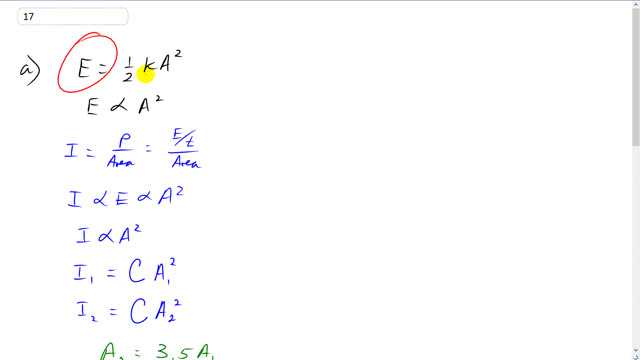
If the amplitude of a sound wave is made 3.5 times greater,
- by what factor will the intensity increase?
- By how many dB will the sound level increase?

In order to watch this solution you need to have a subscription.
This is Giancoli Answers with Mr. Dychko. Way back at the beginning of chapter 11, we learned that the total energy in a spring moving back and forth with simple harmonic motion is 1/2 times the spring constant times the amplitude of its motion squared. Now, it turns out that this formula works for all kinds of waves, doesn't have to involve a spring. Anything, you know, including sound waves which move sinusoidally and with in a simple, you know, simple harmonic way obey the same type of relation, and this constant is 1/2 times effective spring constant. I mean, there's no spring but you can think of it as just some number times the amplitude squared. And so another way to say that is that the energy is proportional to amplitude squared. Now, intensity is power divided by area but power is energy per time. And so intensity equals stuff times energy. And so that makes intensity proportional to energy and since energy is proportional to amplitude squared that makes intensity proportional to amplitude squared. So, intensity is something times amplitude squared, something I just called letter C, doesn't matter what it is because we're gonna be dividing these intensities and so C will cancel anyhow. We know that the amplitude in the second case is 3.5 times the amplitude in the first case. So, when we go intensity 2 divided by intensity 1, we have some constant that we don't care about C times amplitude 2 squared divided by the same constant because it's the same here. Times A1 squared. And the C's cancel. And A2 are replaced with 3.5 times A1. And A1 squared's cancel leaving us with 3.5 squared. So, the ratio of intensities will be about 12 when you go 3.5 squared. The difference in sound levels will be the decibel level of the second intensity minus the decibel sound level of the first intensity. So, decibels is 10 times log of the intensity divided by some reference intensity at the threshold of hearing. We could factor out the 10 and that leaves us with 10 log I2 over I naught minus log I1 over I naught. And there is a logarithm rule that says, when you have subtraction between 2 logarithms, you can do a single logarithm of the first argument divided by the second argument. So, the first argument is I2 over I naught and we're going to divide it by I1 over I naught. But it's easier, instead of dividing fractions by fractions, is easier to multiply by the reciprocal of the bottom fraction. So, I'm going to multiply by I naught over I1 instead of dividing by I1 over I naught. And the I naught's cancel, leaving us with 10 log I2 over I1 and we already know what this ratio is from part a, that's 12.25. And so 10 times log of 12.25 gives us about 11 decibels will be the sound level difference.